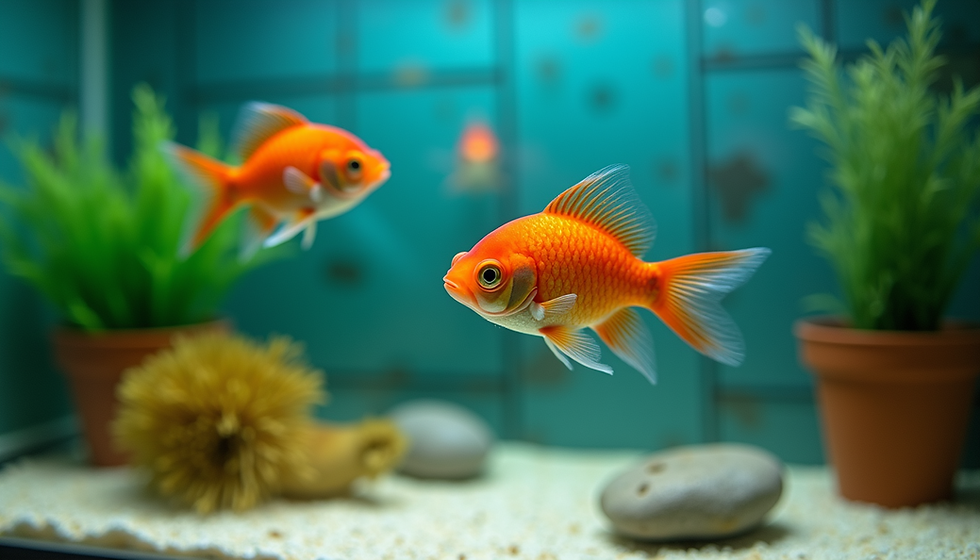Mastering the Art of Keeping Cichlids: A Guide to Thriving Aquatic Communities
- John Wright-Ibarra

- Feb 7, 2024
- 3 min read
Keeping cichlids can be an incredibly rewarding experience for aquarists of all levels. These vibrant and diverse fish are known for their stunning colors, fascinating behaviors, and unique personalities. However, like any other aquarium endeavor, successful cichlid keeping requires careful planning, proper habitat setup, and attentive maintenance. In this guide, we'll delve into the intricacies of cichlid care, offering insights and tips to help you create a thriving aquatic community.
Understanding Cichlids:
Cichlids are a diverse family of fish found in freshwater habitats around the world, from the rivers of Africa and South America to the lakes of Central America. With over 2,000 known species, cichlids come in a wide range of sizes, shapes, and colors, making them a favorite among aquarium enthusiasts.
One of the key characteristics of cichlids is their complex social structure and territorial behavior. Many species exhibit hierarchical dominance within their groups, with dominant individuals asserting control over territories and resources. This behavior adds an interesting dynamic to cichlid aquariums but also requires careful consideration when planning tank mates and habitat arrangements.
Creating the Ideal Habitat:
Setting up a suitable habitat is crucial for the health and well-being of your cichlids. Consider the natural environment of the species you plan to keep and try to replicate it as closely as possible in your aquarium. This may involve providing ample hiding spots, appropriate substrate, and decor that mimics their native surroundings.
When it comes to tank size, larger is generally better, especially for cichlids known for their territorial nature. A spacious aquarium not only provides room for the fish to establish territories but also helps maintain water quality more effectively. Aim for a tank size of at least 20 gallons for small species and larger tanks for larger or more aggressive cichlids.
Water quality is paramount in cichlid aquariums, as these fish are sensitive to fluctuations in temperature, pH, and water chemistry. Regular water testing and maintenance are essential to ensure optimal conditions for your fish. Aim for stable water parameters within the preferred range for your cichlid species.
Choosing Compatible Tank Mates:
Selecting suitable tank mates is crucial for maintaining harmony in a cichlid aquarium. Avoid mixing species with vastly different temperaments or those known to be aggressive towards each other. Instead, opt for compatible species that inhabit different areas of the tank or occupy different niches within the ecosystem.
Additionally, consider the size and aggression level of potential tank mates when making your selections. Avoid overcrowding the tank, as this can lead to increased competition and aggression among the fish. Research each species thoroughly to understand their social dynamics and compatibility with other fish.
Feeding and Nutrition:
Proper nutrition is essential for the health and vitality of your cichlids. These fish are omnivorous, meaning they eat a varied diet that includes both plant matter and protein sources. Provide a balanced diet consisting of high-quality cichlid pellets or flakes supplemented with live or frozen foods such as bloodworms, brine shrimp, and vegetable matter.
Feed your cichlids small, frequent meals throughout the day rather than a large amount all at once. This helps prevent overfeeding and maintains water quality in the aquarium. Monitor your fish closely for signs of overeating or malnutrition, and adjust their diet accordingly.
Observing and Enjoying Your Cichlids:
One of the greatest joys of keeping cichlids is observing their fascinating behaviors and interactions within the aquarium. Take the time to observe your fish regularly, noting any changes in behavior, appearance, or appetite. This can help you identify potential issues early and take corrective action before they escalate.
Experiment with different tank layouts and decorations to provide enrichment for your cichlids and encourage natural behaviors such as breeding, foraging, and territorial defense. With patience and dedication, you can create a vibrant and dynamic aquatic community that brings joy and fascination for years to come.
Conclusion:
Keeping cichlids can be a challenging yet immensely rewarding endeavor for aquarium enthusiasts. By understanding their natural behaviors, providing suitable habitat conditions, and selecting compatible tank mates, you can create a thriving aquatic ecosystem that showcases the beauty and diversity of these remarkable fish. With proper care and attention, your cichlids will flourish, delighting you with their vibrant colors, unique personalities, and captivating behaviors.





Comments